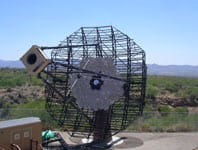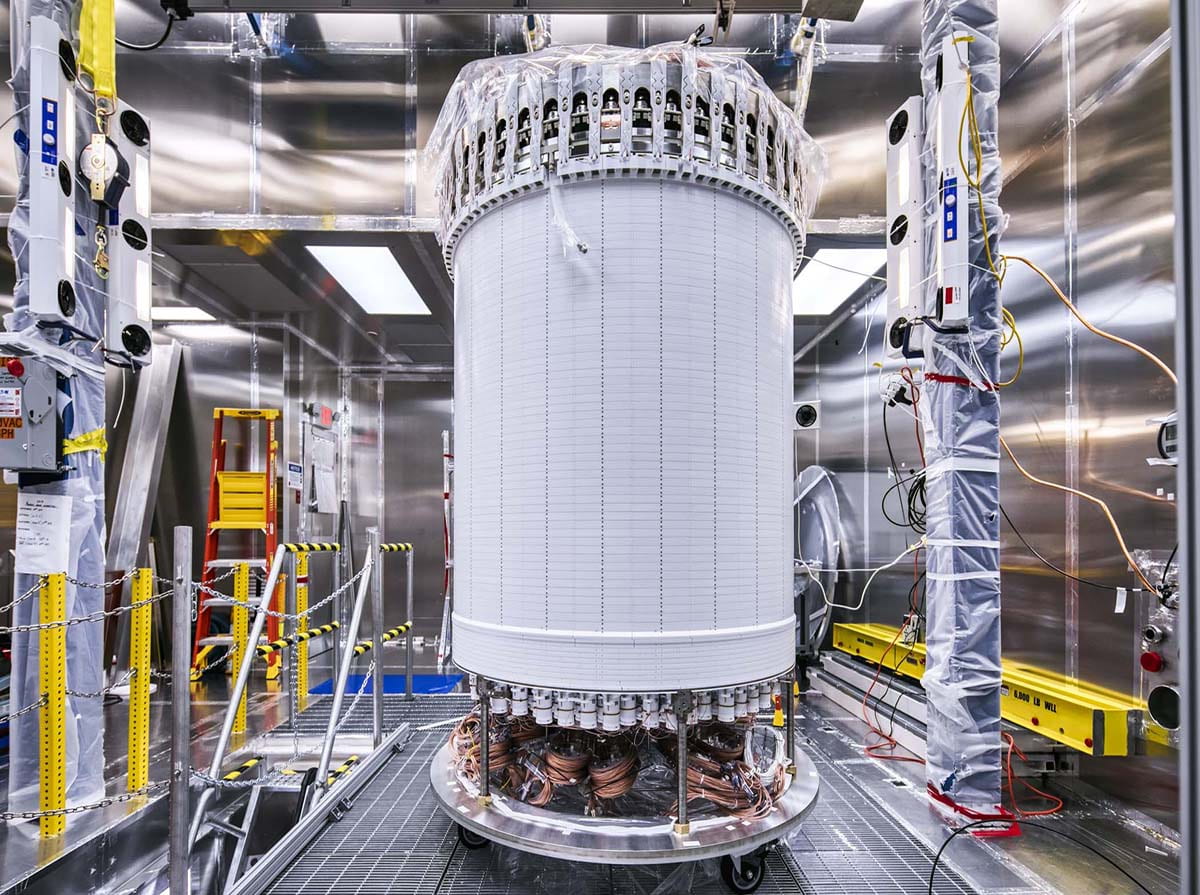Projects
AMON
 The Astrophysical Multimessenger Observatory Project (AMON) is a program under development at Penn State in collaboration with a growing list of U.S. and international observatories. AMON seeks to perform a real-time correlation analysis of the high-energy signals across all known astronomical messengers – photons, neutrinos, cosmic rays and gravitational waves. It will enhance the combined sensitivity of collaborating observatories to astrophysical transients by searching for coincidences in their sub-threshold data; and it will enable rapid follow-up imaging or archival analysis of the putative astrophysical sources. For more information, see the AMON paper at ScienceDirect.
The Astrophysical Multimessenger Observatory Project (AMON) is a program under development at Penn State in collaboration with a growing list of U.S. and international observatories. AMON seeks to perform a real-time correlation analysis of the high-energy signals across all known astronomical messengers – photons, neutrinos, cosmic rays and gravitational waves. It will enhance the combined sensitivity of collaborating observatories to astrophysical transients by searching for coincidences in their sub-threshold data; and it will enable rapid follow-up imaging or archival analysis of the putative astrophysical sources. For more information, see the AMON paper at ScienceDirect.
Gravitational Wave Physics and Astrophysics
 The gravitational wave physics and astrophysics activities at the CPGA include several faculty, postdocs and graduate students involved in various projects. These include the astrophysics of gravitational wave sources, numerical relativity, gravitational wave detection and data analysis techniques (as part of the LIGO collaboration) and analysis techniques for detection of gravitational waves through Pulsar Timing Arrays and other systems.
The gravitational wave physics and astrophysics activities at the CPGA include several faculty, postdocs and graduate students involved in various projects. These include the astrophysics of gravitational wave sources, numerical relativity, gravitational wave detection and data analysis techniques (as part of the LIGO collaboration) and analysis techniques for detection of gravitational waves through Pulsar Timing Arrays and other systems.
HAWC
 The High Altitude Water Cherenkov (HAWC) experiment is designed to observe gamma rays and cosmic rays between 100 GeV and 100 TeV. TeV gamma rays are the highest energy photons ever observed — 1 TeV is 1 trillion electron volts (eV), about 1 trillion times more energetic than visible light! These photons are born in the most extreme environments in the known universe: supernova explosions, active galactic nuclei, and gamma-ray bursts. Cosmic rays are charged particles which achieve energies far beyond what we can create in man-made particle accelerators. (The highest energy cosmic ray ever observed was 300 million TeV.) The origin of such particles has been a mystery for over 100 years. Gamma rays are though to be correlated with the acceleration sites of charged cosmic rays, so we observe them to help answer this and other cosmic questions. HAWC is located on the flanks of the Sierra Negra volcano near Puebla, Mexico at an altitude of 4100 meters (13,500 feet). The detector has an instantaneous field of view covering 15% of the sky, and during each 24 hour period HAWC observes two-thirds of the sky. Using the HAWC Observatory, we are performing a high-sensitivity synoptic survey of the gamma rays from the Northern Hemisphere.
The High Altitude Water Cherenkov (HAWC) experiment is designed to observe gamma rays and cosmic rays between 100 GeV and 100 TeV. TeV gamma rays are the highest energy photons ever observed — 1 TeV is 1 trillion electron volts (eV), about 1 trillion times more energetic than visible light! These photons are born in the most extreme environments in the known universe: supernova explosions, active galactic nuclei, and gamma-ray bursts. Cosmic rays are charged particles which achieve energies far beyond what we can create in man-made particle accelerators. (The highest energy cosmic ray ever observed was 300 million TeV.) The origin of such particles has been a mystery for over 100 years. Gamma rays are though to be correlated with the acceleration sites of charged cosmic rays, so we observe them to help answer this and other cosmic questions. HAWC is located on the flanks of the Sierra Negra volcano near Puebla, Mexico at an altitude of 4100 meters (13,500 feet). The detector has an instantaneous field of view covering 15% of the sky, and during each 24 hour period HAWC observes two-thirds of the sky. Using the HAWC Observatory, we are performing a high-sensitivity synoptic survey of the gamma rays from the Northern Hemisphere.
Research
IceCube
 The IceCube Neutrino Detector is a neutrino telescope currently under construction at the South Pole. Like its predecessor, the Antarctic Muon And Neutrino Detector Array (AMANDA), IceCube is being constructed in deep Antarctic ice by deploying thousands of spherical optical sensors (photomultiplier tubes, or PMTs) at depths between 1,450 and 2,450 meters. The sensors are deployed on “strings” of sixty modules each, into holes in the ice melted using a hot water drill.
The IceCube Neutrino Detector is a neutrino telescope currently under construction at the South Pole. Like its predecessor, the Antarctic Muon And Neutrino Detector Array (AMANDA), IceCube is being constructed in deep Antarctic ice by deploying thousands of spherical optical sensors (photomultiplier tubes, or PMTs) at depths between 1,450 and 2,450 meters. The sensors are deployed on “strings” of sixty modules each, into holes in the ice melted using a hot water drill.
Research
Pierre Auger
 The Pierre Auger Cosmic Ray Observatory is studying ultra-high energy cosmic rays, the most energetic and rarest of particles in the universe. When these particles strike the earth’s atmosphere, they produce extensive air showers made of billions of secondary particles. While much progress has been made in nearly a century of research in understanding cosmic rays with low to moderate energies, those with extremely high energies remain mysterious.
The Pierre Auger Cosmic Ray Observatory is studying ultra-high energy cosmic rays, the most energetic and rarest of particles in the universe. When these particles strike the earth’s atmosphere, they produce extensive air showers made of billions of secondary particles. While much progress has been made in nearly a century of research in understanding cosmic rays with low to moderate energies, those with extremely high energies remain mysterious.
Research
Swift
 The Swift Gamma Ray Burst Explorer carries three instruments to enable the most detailed observations of gamma ray bursts to date. Two of these instruments, the X-ray Telescope (XRT) and the UV/Optical Telescope (UVOT) were built by Penn State and collaborators at Leicester University and the Mullard Space Science Laboratory (both in England) and at the Osservatorio Astronomico di Brera (in Italy). In addition, Penn State is responsible for leading the Education and Public Outreach component of this mission, as well as the Mission Operations Center, which operates the satellite.
The Swift Gamma Ray Burst Explorer carries three instruments to enable the most detailed observations of gamma ray bursts to date. Two of these instruments, the X-ray Telescope (XRT) and the UV/Optical Telescope (UVOT) were built by Penn State and collaborators at Leicester University and the Mullard Space Science Laboratory (both in England) and at the Osservatorio Astronomico di Brera (in Italy). In addition, Penn State is responsible for leading the Education and Public Outreach component of this mission, as well as the Mission Operations Center, which operates the satellite.
Research
VERITAS
 VERITAS (Very Energetic Radiation Imaging Telescope Array System) is a new major ground-based gamma-ray observatory with an array of four 12m optical reflectors for gamma-ray astronomy in the GeV – TeV energy range. The telescope design is based on the design of the existing 10m gamma-ray telescope of the Whipple Observatory. It consists of an array of imaging telescopes deployed such that they permit the maximum versatility and give the highest sensitivity in the 50 GeV – 50 TeV band (with maximum sensitivity from 100 GeV to 10 TeV). This VHE observatory will effectively complement GLAST.
VERITAS (Very Energetic Radiation Imaging Telescope Array System) is a new major ground-based gamma-ray observatory with an array of four 12m optical reflectors for gamma-ray astronomy in the GeV – TeV energy range. The telescope design is based on the design of the existing 10m gamma-ray telescope of the Whipple Observatory. It consists of an array of imaging telescopes deployed such that they permit the maximum versatility and give the highest sensitivity in the 50 GeV – 50 TeV band (with maximum sensitivity from 100 GeV to 10 TeV). This VHE observatory will effectively complement GLAST.
Research
LZ Dark Matter Experiment
Dark matter comprises about 85% of the mass of the Universe, and its particle nature is still unknown. Liquid Xe detectors have been a game changer in the field of dark matter detection, bringing about astonishing improvements in sensitivity over the past decade. The LUX-ZEPLIN (LZ) collaboration has grown out of these two precursor experiments, with the goal of constructing a next generation dark matter detector at the Sanford Underground Research Facility (SURF) in Lead, South Dakota, using a dual-phase time projection chamber with 10 tonnes of xenon. This experiment aims to achieve unprecedented sensitivity to weakly interacting massive particles (WIMPs) and is projected to reach a WIMP-nucleon spin-independent cross section of about 1.6×10^{-48} cm^2 in 3 years of operation. The LZ experiment is well underway, and slated to start taking data in 2021.
Website for LUX: http://luxdarkmatter.org
Website for LZ: https://lz.lbl.gov
Project 8 Experiment
 The Project 8 experiment seeks to determine the neutrino mass via the precise measurement of the electron energy in beta decays. We have developed and demonstrated the viability of a novel technique called Cyclotron Radiation Emission Spectroscopy (CRES), which allows single electron detection and characterization through the measurement of cyclotron radiation emitted by magnetically-trapped electrons produced by a gaseous radioactive source. We are currently working on the first CRES measurement using a tritium source, and the design of a large scale detector aimed at measuring the neutrino mass.
The Project 8 experiment seeks to determine the neutrino mass via the precise measurement of the electron energy in beta decays. We have developed and demonstrated the viability of a novel technique called Cyclotron Radiation Emission Spectroscopy (CRES), which allows single electron detection and characterization through the measurement of cyclotron radiation emitted by magnetically-trapped electrons produced by a gaseous radioactive source. We are currently working on the first CRES measurement using a tritium source, and the design of a large scale detector aimed at measuring the neutrino mass.
Website for Project8: http://www.project8.org

